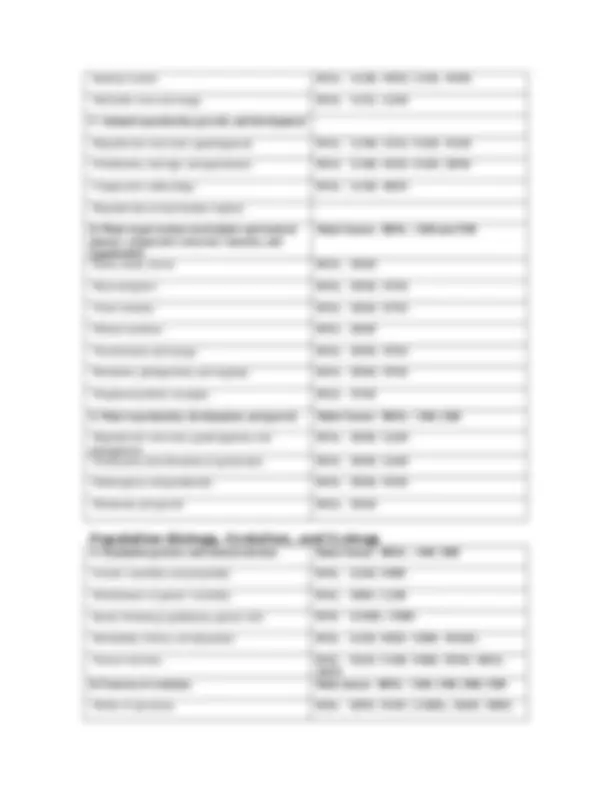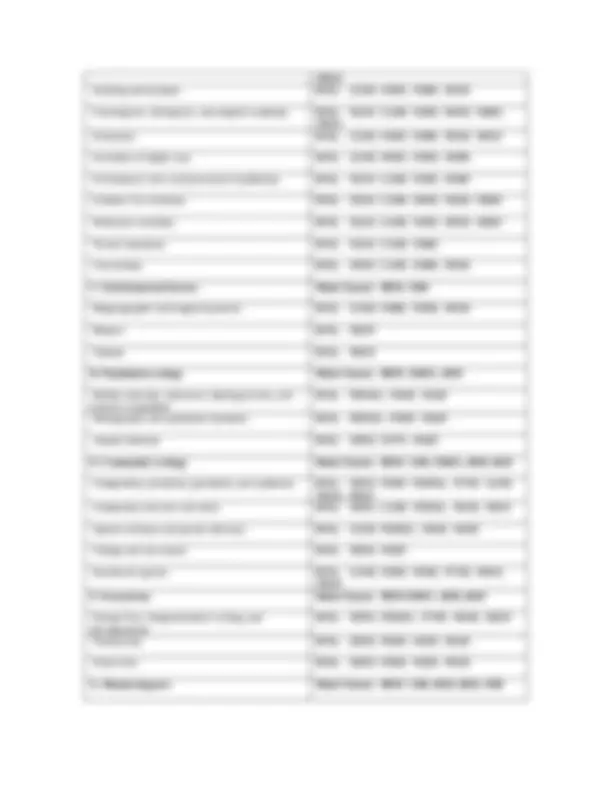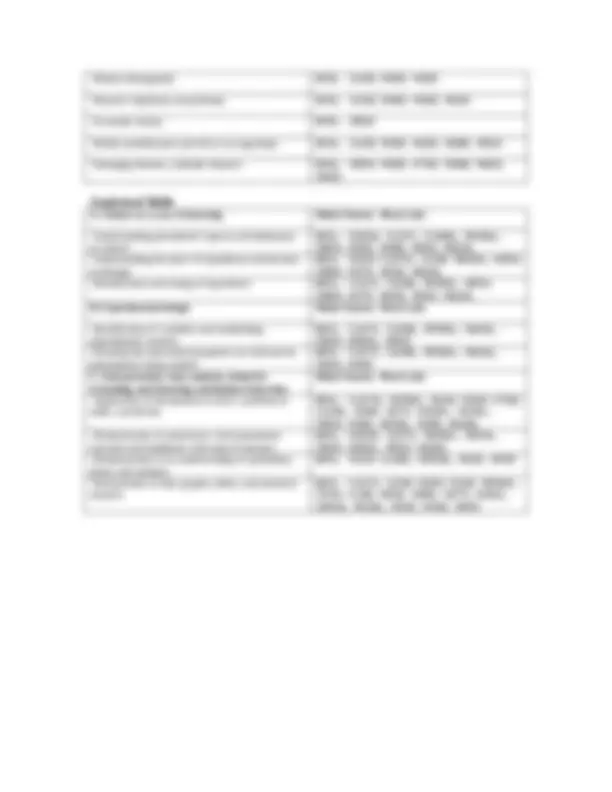





Study with the several resources on Docsity

Earn points by helping other students or get them with a premium plan


Prepare for your exams
Study with the several resources on Docsity

Earn points to download
Earn points by helping other students or get them with a premium plan
Community
Ask the community for help and clear up your study doubts
Discover the best universities in your country according to Docsity users
Free resources
Download our free guides on studying techniques, anxiety management strategies, and thesis advice from Docsity tutors
Material Type: Exam; Class: Principles of Biology I; Subject: Biology; University: Clayton State University; Term: Unknown 1989;
Typology: Exams
1 / 5

This page cannot be seen from the preview
Don't miss anything!




A. Biochemistry and cell energetics Main Classes: BIOL: 1107, 3200, 3250 Biological compounds and macromolecules BIOL: 3250, 1107, 3200
Enzyme activity and regulation BIOL: 3250, 1107, 3200, 4930 ATP and energy-producing pathways BIOL: 3250; 1107, 3200, 2500 First and second laws of thermodynamics BIOL: 3250, 1107 Cell-cell communication BIOL: 3250; 1107, 3200, 1151, 4100, 4160, 2500, 4930 B. Cellular structure, organization, and function Main Classes: BIOL: 1107, 3200, 3250 Organelles and other cellular components BIOL: 3250; 1107; 3200, 1151, 2500, 4930 Cytoskeleton and cell motility BIOL: 3250; 1107; 3200 Cell surfaces and membrane function BIOL: 3250; 1107; 3200, 1151, 4100, 4930, 4460 Extracellular space BIOL:^ 3250 1107; 3200, 1151, 4100, 2500 Cell theory, germ theory BIOL: 3250; 1107 and 3200, 4600 Distinctions among archaebacteria, eubacteria, and eukaryotic cells
Cell growth, cell cycle, mitosis, and cytokinesis BIOL:^ 3250, 1107, 3200, 4930 Molecular Biology and Genetics A. Molecular genetics Main Classes: BIOL: 1107, 3250, 4201, 3100, 4202 DNA replication and mutation BIOL: 3250, 3100, 1107, 4201, 4202, 4930 Gene structure, introns, and exons BIOL: 3250, 3100, 1107, 4201, 4202 Regulation of gene expression BIOL: 3250, 3100, 4201, 4202, 4460 RNA transcription and modification BIOL: 3250, 3100, 1107, 4201, 4202, 4460 Translation of mRNA BIOL: 3250, 3100, 1107, 4201, 4202 Bacteriophages and viruses BIOL:^ 3250, 4460, 4600, 4620 Control of normal development; cancer BIOL: 1107, 3200, 4930, 4201, 4460 Molecular aspects of immunology BIOL: 3250, 4450, 4460 Genetic engineering BIOL: 3100, 1107; 4201, 4202, 4460
B. Heredity Main Classes: BIOL: 1107, 4201 Meiosis and chromosomal alterations BIOL:^ 1107, 4201, 4930 Modes of inheritance BIOL: 1107, 4201 Probability and pedigree analysis BIOL: 1107, 4201 Segregation, recombination, and chromosome mapping
Polyploidy and aneuploidy BIOL: 1107; 4201 Sex determination BIOL:^ 1107; 4201 Non-Mendelian inheritance BIOL: 1107; 4201 Prokaryote genetics BIOL: 3250, 4600, 4620
A. Diversity of organisms ( Phylogenetic relationships, classification, morphology, life histories, and general biology of:…) Main Classes: BIOL: 3250, 1108, 3380, 2500 bacteria and archaea BIOL: 3250, 4600, 4620 fungi BIOL: 3250, 2500, 1108/L, 4620, 4630 plants BIOL:^ 2500, 3700, 1108/L animals BIOL: 1108/L, 3650, 3300, 3500 Origin of life and endosymbiont theory BIOL: 1108, 3250, 3380, 3200 Fossil record and human evolution BIOL: 1108, 3300, 3650, 3380 Systematics and molecular phylogeny BIOL: 1108, 3100, 3650, 3380, 3250, 4620, 4460 Adaptations of organisms to habitats BIOL: 2500, 1108, 3500, 3650, 3380, 4620 B. Animal organ systems (vertebrates and invertebrates): comparative structure, function, and organization Main Classes: BIOL: 1108/L, 3650/L, 4100, 1152 Digestion and nutrition BIOL: 1108/L, 1152, 1108, 3650/L Excretion and osmoregulation BIOL: 1108/L, 1152, 4100, 1108, 3650/L, 4930 Gas exchange and ventilation BIOL: 1108/L, 1152, 4100, 1108, 3650/L Circulatory systems BIOL: 1108/L, 1152, 4100, 1108, 3650/L, 4930 Support and movement BIOL: 1152, 3300, 4100, 1108/L, 3650/L Nervous and endocrine systems BIOL: 1152, 1151, 4100, 4160, 1108/L, 3650/L, 4120, 4930, 3200 Integument BIOL: 1151, 1108/L, 3650/L
Isolating mechanisms BIOL: 1108, 3300, 3380, 3500 Convergence, divergence, and adaptive radiation BIOL: 3100, 1108, 3300, 3650, 3380, 3500 Extinction BIOL: 1108, 3300, 3380, 3500, 3650 Evolution of higher taxa BIOL: 1108, 3650, 3300, 3380 Evolutionary rates and punctuated equilibrium BIOL: 3100, 1108, 3300, 3380 Evidence for evolution BIOL: 3100, 1108, 3650, 3300, 3380 Molecular evolution BIOL: 3100, 1108, 3300, 3650, 3380 Neutral mutations BIOL: 3100, 1108, 3380 Coevolution BIOL: 2500, 1108, 3380, 3500 C. Environmental factors Main Classes: BIOL 3500 Biogeographic and temporal patterns BIOL: 1108, 3380, 3500, 4920 Biomes BIOL: 3500 Climate BIOL: 3500 D. Population ecology Main Classes: BIOL 3500/L, 4920 Habitat selection, tolerances, limiting factors, and resource acquisition
Demography and population dynamics BIOL: 3500/L, 4920, 4620 Animal behavior BIOL: 3300, 3375, 4920 E. Community ecology Main Classes: BIOL 1108, 3500/L, 4920, 4620 Competition, predation, parasitism, and symbiosis BIOL: 3250, 3300, 3500/L, 3700, 1108, 4620, 4920 Community structure and niche BIOL: 3250, 1108, 3500/L, 4620, 4920 Species richness and species diversity BIOL: 1108, 3500/L, 4620, 4920 Change and succession BIOL: 3500, 4920 Introduced species BIOL: 1108, 3300, 3500, 3700, 4920, 4620 F. Ecosystems Main Classes: BIOL3500/L, 4920, 4620 Energy flow, biogeochemical cycling, and decomposition
Productivity BIOL: 2500, 3500, 4620, 4920 Food webs BIOL: 3250, 3500, 4620, 4920 G. Human impacts Main Classes: BIOL 1108, 4620, 4920, 3500
Human demography BIOL: 1108, 3500, 4920 Resource depletion and pollution BIOL:^ 1108, 3500, 4620, 4920 Economic botany BIOL: 2500 Habitat modification and effects on organisms BIOL: 1108, 3500, 4620, 3380, 4920 Emerging diseases, endemic diseases BIOL: 3250, 4600, 3700, 3380, 4920, 4620
A. Science as a way of knowing Main Classes: Most Labs Understanding quantitative aspects and limitations of science
Understanding the place of hypotheses and theories in biology
Identification and testing of hypotheses BIOL: 1107L, 1108L, 3500/L, 3650, 3380, 3375, 4920, 4930, 4620L B. Experimental design Main Classes: Most Labs Identification of variables and establishing experimental controls
Ensuring that measured parameters are affected by phenomenon being studied
C. Interpretation, data analysis, inductive reasoning, and drawing conclusions from data Main Classes: Most Labs Application of information to solve a problem or make a prediction
Demonstration of proficiency with quantitative concepts and familiarity with units of measure
Demonstration of an understanding of probability theory and statistics
Interpretation of data, graphs, tables, and statistical analyses